AISC Tables 9-3a,b, and C for the Block shear-coped beam.
In this post, we will verify by the use of AISC tables 9-3a,b, and C for the block shear-coped beam to check the solution of solved problem #5.13 from Prof. Alan Williams‘s handbook.
The solved problem was included in post 19, for which it was required to find out the block shear for the coped beam where UBS equals 1.00, which is the case where we have a uniform stress distribution for tension force.
It is required to determine the resistance to block shear of the coped beam W16x40 grade A36.
The horizontal distance between the beam edge and the center line of the first line of bolts is 1.50 inches, and the vertical distance between the edge of the beam to the first line of bolts is 1.5 inches. While the vertical spacing between bolts is 3 inches as shown in the next slide image. The bolt diameter is 3/4 inches.


This is an elevation section to show the beam, the number, and arrangement of bolts, and the vertical and horizontal distance between the edge of the coped beam and the bolts.


AISC Table 9-3a for tensile rupture for block shear.
We start with AISC table 9-3a, which is the first AISC table of the three AISC tables to be used for block shear evaluation.
The coefficient for block shear UBS equals 1. Aisc table 9-3a determines both the LRFD and ASD value for the block shear tension rupture component of the block shear, but the estimated values are for kips per unit inch.
We have Ultimate stress equals 58 ksi, we log in with the first column of Leh values, and we select Leh value of 1.50 inches where leh is the horizontal distance from the edge to the first line of bolts. The bolt diameter is 3/4 inches, and the intersection between the horizontal line from Leh equals 1.50″ line and the two vertical lines from the bolt column of 3/4 inches will give us both the LRFD value and the ASD value for tensile rupture.
As we can see The LRFD value of tensile rupture equals 46.20 kips/inch, while the ASD value for tensile rupture equals 30.80 kips/inch.
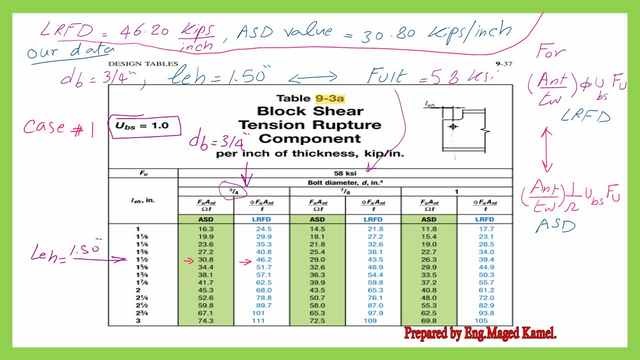

AISC Table 9-3b for shear yielding component.
Here comes the second AISC table, of the three AISC tables, which is table 9-3b, which is used for estimating the shear-yielding component of block shear. The yield stress is 36 ksi.
The first column is for Lev which is the vertical distance between the edge and the first line of bolts, also we need the S value which is the spacing between bolts.
Column n specifies the number of bolts, in our example, we have three bolts so n equals 3.
The horizontal line from Lev=1.50 inches and n=3 is drawn and intersects with the lines from Fy=36 ksi will give the two values for LRFD and ASD of the shear-yielding components for block shear.
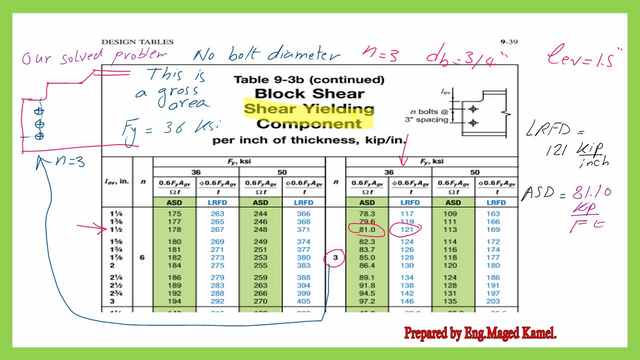

As we can see The LRFD value of the shear-yielding component equals 121 kips/inch, while the ASD value for tensile rupture equals 81.1 kips/inch.
AISC Table 9-3C for shear rupture component.
This is the third AISC table, the last table of the three AISC tables, which is table 9-3C, which is used for estimating the shear rupture component of block shear. The ultimate stress is 58/ ksi.
The first column is for n the number of bolts which equals 3 bolts.
The second columnthe is lev column. We draw a line with n=3 and lev equals 1.50 inches. We draw two vertical lines from the bolt column where db=3/4 inches. We will get two values for LRFD and ASD for the shear rupture component. The LRFD value equals 139 kips /inch. The ASD value equals 92.40 kips/inch.
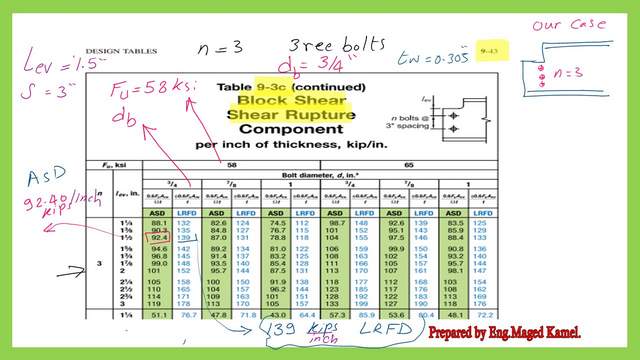

We can see the results for The LRFD values for tension rupture, shear yielding, and shear rupture from AISC tables 9-3a, 9.-3b, and 9-3c. We multiply each value by the web thickness of the web tw which equals 0.305 inches.


We have two values for the LRFD from two cases, the first case is the case of shear yielding and tension rupture for which the sum of the two values is approximately 51.0 kips.
The second case is the case of shear rupture and tension rupture for which the sum of the two values is approximately 56.49 kips. We will select the smaller value which is 51.00 kips.
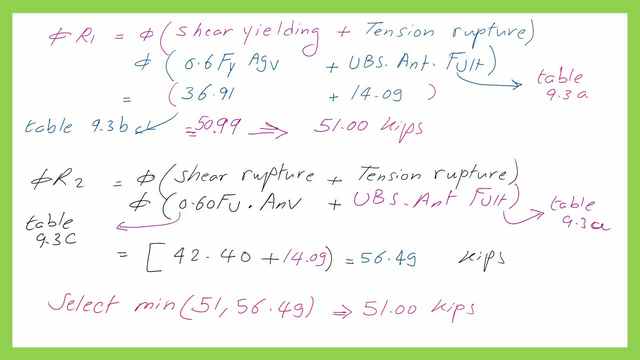

This is a reminder of the previously estimated LRFD value for block shear based on the calculation, please refer to the previous post for more detailed information. there is a match between this estimation and the one obtained by using tables for the LRFD value.
We can see the results for The ASD values for tension rupture, shear yielding, and shear rupture from AISC tables 9-3a, 9.-b, and 9-3c. We multiply each value by the web thickness of the web tw which equals 0.305 inches.
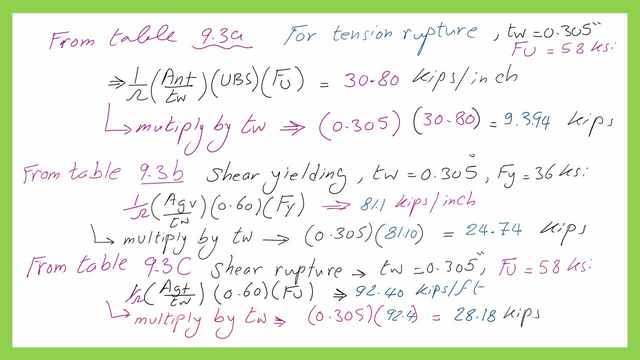

We have two values for ASD from two cases, the first case is the case of shear yielding and tension rupture for which the sum of the two values is approximately 34.14 kips. The second case is the case of shear rupture and tension rupture for which the sum of the two values is approximately 37.57 kips. We will select the smaller value which is 34.14 kips.
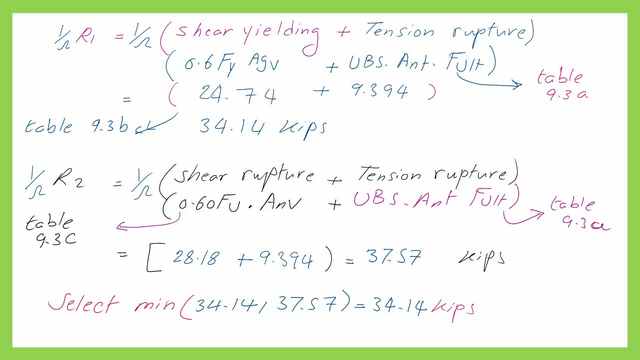

This is a reminder of the previously estimated ASD value for block shear based on the calculation, please refer to the previous post for more detailed information. there is a match between this estimation and the one obtained by using tables for the LRFD value.
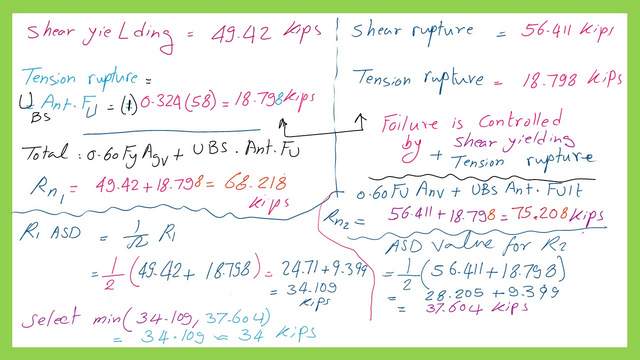

Post-19-Solutions for Block Shear-Coped Beam Problem.
The next post: Post 21-Case 2 for the block Shear-Coped Beam Problem.
For a more detailed illustration of block shear, there is a very useful external link yielding and tensile rupture. A Beginner’s Guide to the Steel Construction Manual, 14th ed.

